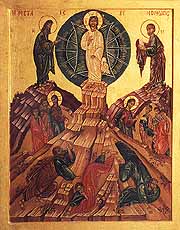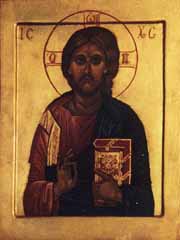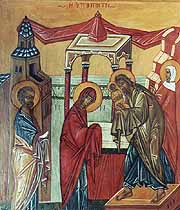The Art and
Language
of Iconography
 A Byzantine
Orthodox icon is the expression of the divine dispensation that epitomizes the
fundamental teaching of the Orthodox Church that: “God became man in order for
man to become God.” The most frequently asked question from people who expose
themselves to Byzantine hagiography is “Why is this particular type of art not
natural? Why do the people sketched on a Byzantine icon reflect a supernatural
mode of depiction?”
A Byzantine
Orthodox icon is the expression of the divine dispensation that epitomizes the
fundamental teaching of the Orthodox Church that: “God became man in order for
man to become God.” The most frequently asked question from people who expose
themselves to Byzantine hagiography is “Why is this particular type of art not
natural? Why do the people sketched on a Byzantine icon reflect a supernatural
mode of depiction?”
Byzantine art is an artistic expression that mingles the natural with the supernatural elements of presentation. It elevates our senses from the real and the conceivable diminution to a spiritual and supernatural level of existence. It converts our physical eyes to spiritual binoculars thus enabling us to penetrate the charismatic depiction of the divine grace. This method is called reduction. Reductionism is the transformation of the natural shapes and colors into spiritual entities.
The colors and shapes that a Byzantine hagiographer
conveys in his artistic expression become mystical in order for him to be able
to depict the supernatural world of the spirit. In other words, an icon is a
transcendental spiritual representation and not a mere religious drawing. An
icon has its own character and its own particular rules of presentation.

A Byzantine Orthodox icon is to an extent not a product created by the distorted and sinful nature of our fallen world, but a product of the spiritually renewed and restored nature. It is the symbol and the way; it is the prayer incarnate. That reality reflects in the icon the significance and the simplicity, the tranquil motion, and the rhythm of the colors, so in a rather pious mode, it transmits to its viewer a perfect harmony. The beauty of the liturgical hagiography is a spiritual, not a material, fruit. Orthodox hagiography is ablative, stripped from any superfluous and unnecessary depictions and presentations.
Our Church elevated the position of the icon to a level that proclaimed spiritual victory against the iconoclast; a victory which was established as a part of its liturgical tradition, always celebrated the first Sunday of Great Lent and is called the feast of the restoration of the Icons.
 Orthodox icons
have descriptive force so great that it that engulfs tremendous semeiological
meanings. They are spiritual icons, realities that abolish time, space, gravity,
form etc. For an icon everything seems to obey the laws of the spiritual world.
Orthodox icons
have descriptive force so great that it that engulfs tremendous semeiological
meanings. They are spiritual icons, realities that abolish time, space, gravity,
form etc. For an icon everything seems to obey the laws of the spiritual world.
For a Christian, an icon is not an item that underscores an aesthetic pleasure or triggers a scientific curiosity; it is rather an entity with theological implications. While secular art depicts the realities of our sensual and dimensional world, an icon depicts the reality of the Kingdom of God; a reality that constitutes the fundamental principle and teaching of our Church. In other words, the art of Orthodox hagiography depicts with certain symbols this same world that we all live in today, renewed and deprived from its sinful nature.
![]()